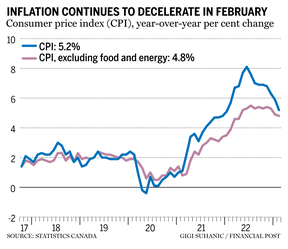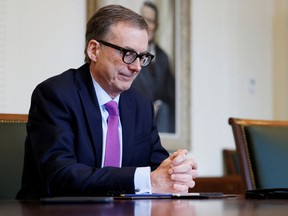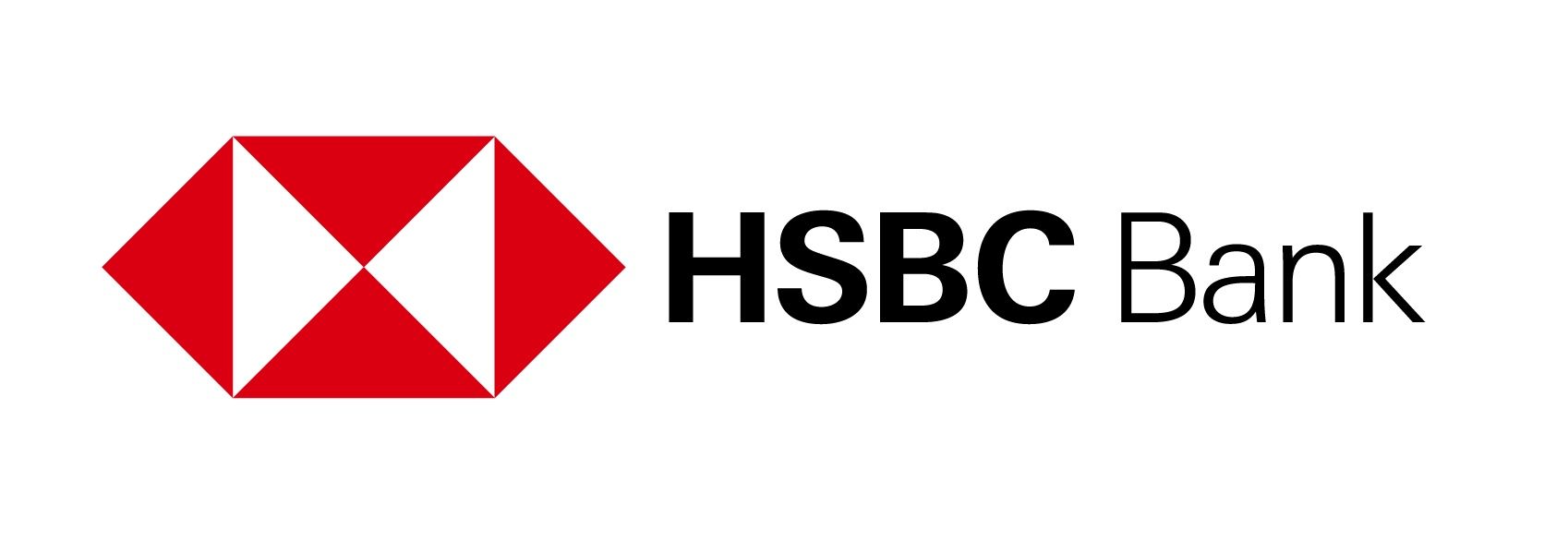Kevin Carmichael: Reading gives Bank of Canada enough evidence to stay on hold, but not enough to call it quits

Article content
Headline inflation decelerated to its slowest in more than a year in February, suggesting the Bank of Canada will keep interest rate increases on hold. Here’s what you need to know:
Advertisement 2
Article content
- Statistics Canada’s consumer price index increased 5.2 per cent from February 2022, compared with a year-over-year increase of 5.9 per cent in January.
- The index increased 0.4 per cent on the month, compared with a gain of 0.5 per cent in January from December.
- Excluding food and energy costs, the index increased 4.8 per cent from February 2022, compared with a year-over-year increase of 4.9 per cent in January.
- Food purchased from stores rose 10.6 per cent from February 2022, the seventh consecutive month of double-digit increases.
- Energy prices decreased 0.6 per cent on the year, compared with a year-over-year gain of 5.4 per cent in January, as gasoline prices declined for the first time since the start of 2021.
- The cost of services — a number the Bank of Canada said it will be watching — increased 5.3 per cent year over year, unchanged from January and down from 5.6 per cent in December.
Article content
Article content
Advertisement 3
Article content

Backstory
The pandemic broke supply chains and created pent-up demand for goods and services that could be relatively easily satiated due to unprecedented rescue packages in the world’s richest countries. Russia’s invasion of Ukraine further constrained supplies of energy and fertilizer. And an unexpectedly swift recovery from the COVID-19 recession caused demand to outpace supply. Put all those things together, and central banks entered 2022 facing the most severe burst of inflation since the early 1980s — and one they are still struggling to contain.
Article content
Inflation jumped out of the upper end of the Bank of Canada’s comfort zone of one per cent to three per cent in April 2021, surged to almost five per cent by the end of the year and peaked at 8.1 per cent in June 2022.
Advertisement 4
Article content
Bank of Canada governor Tiff Macklem acknowledged he was caught off guard by the strength of inflation, which he initially thought would pass once supply chains righted themselves. He raised the central bank’s benchmark interest rate by 4.25 percentage points between March 2022 and January 2023, the most aggressive series of rate increases ever.
Inflation is finally slowing
Year-over-year price increases are back to where they were at the start of 2022, when some Bay Street economists were saying the Bank of Canada was waiting too long to start raising interest rates. (The benchmark rate was still at its crisis setting of 0.25 per cent and the Bank of Canada didn’t start adjusting it until March 2022.)
Inflation is still too high, considering the Bank of Canada’s target is two per cent. But February marked the first time in ages that average hourly wages, which increased 5.4 per cent year over year, grew faster than the cost of living.
Advertisement 5
Article content
Increases in the cost of food, shelter, transportation and recreation all eased in February, while the cost of clothing and footwear, household operations and furnishings, and alcohol, tobacco and cannabis accelerated, Statistics Canada said.
What does it mean for interest rates?
All things equal, the sharp deceleration of the headline number will allow the Bank of Canada to leave interest rates on hold again when policymakers gather next month to deliberate over their next move. Macklem is looking for definitive evidence that inflation is tracking back to the central bank’s target of two per cent, and the largest drop since April 2020 counts as such.
Still, central bankers are worried that inflation could get stuck at the top end of their comfort zone. The latest numbers won’t alleviate those concerns. The big decline in the year-over-year rate is the result of “base-year effects,” and not necessarily a big change in economic conditions. Prices were increasing rapidly a year ago, pushing the index higher. Those elevated levels are now the benchmark for comparisons with what prices are doing now, so much of the decline is explained by simple math.
Advertisement 6
Article content

The sight of inflation closer to five per cent than eight per cent could give households hope that things are getting better, which might counter expectations that inflation has become entrenched. Yet there are signs of entrenchment.
Statistics Canada’s measure of “core” inflation, which subtracts volatile food and energy costs, is sticking near five per cent. That suggests inflation has spread beyond key input prices and is now being reflected in most goods and services.
Macklem might have enough evidence to stay on hold, but not enough to definitively decide that no more interest rate increases will be needed.
What Bay Street is saying
Claire Fan, economist, Royal Bank of Canada
“The Bank of Canada set a relatively high bar to restart interest rates after foregoing an increase in the overnight rate for the first time in a year in March. Recent financial market turmoil has, if anything, raised that bar higher.”
Advertisement 7
Article content
Royal’s rate forecast: “BoC on the sidelines until the end of 2023.”
Veronica Clark, economist, Citigroup Global Markets
“We see little in the details of CPI to change the backdrop of still-strong underlying inflationary pressures.”
Citi’s rate forecast: “We see a roughly split likelihood of a hike in April or June. Notably, however, even rates on hold would be substantially higher than cuts currently priced by markets. We see cuts as very unlikely until the run-rate of core inflation measures are at least substantially in the (one per cent to three per cent) range.”
Leslie Preston, senior economist, Toronto-Dominion Bank
“Inflation in Canada continues to cool from its peak pace last year. However, with the core measures just below five per cent, they still have a way to go before they are comfortably within the Bank of Canada’s target (one per cent to three per cent) range.”
TD’s rate forecast: “There was nothing in today’s inflation report that would move the Bank of Canada off its pause on interest rate moves.”
-

Loblaw’s Galen Weston faces his critics during visit to Parliament Hill
-

How the grocery oligopoly dulled competition and fuelled inflation
• Email: kcarmichael@postmedia.com | Twitter: carmichaelkevin
Canada inflation slows but food prices stay high
2023-03-21 13:38:02








Comments
Postmedia is committed to maintaining a lively but civil forum for discussion and encourage all readers to share their views on our articles. Comments may take up to an hour for moderation before appearing on the site. We ask you to keep your comments relevant and respectful. We have enabled email notifications—you will now receive an email if you receive a reply to your comment, there is an update to a comment thread you follow or if a user you follow comments. Visit our Community Guidelines for more information and details on how to adjust your email settings.
Join the Conversation